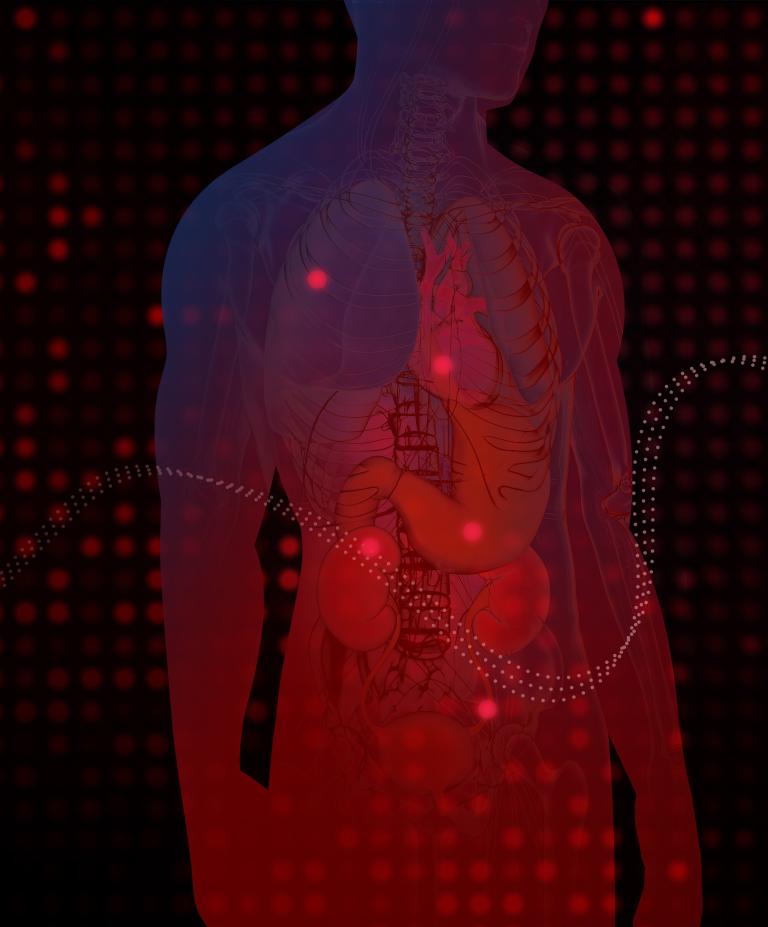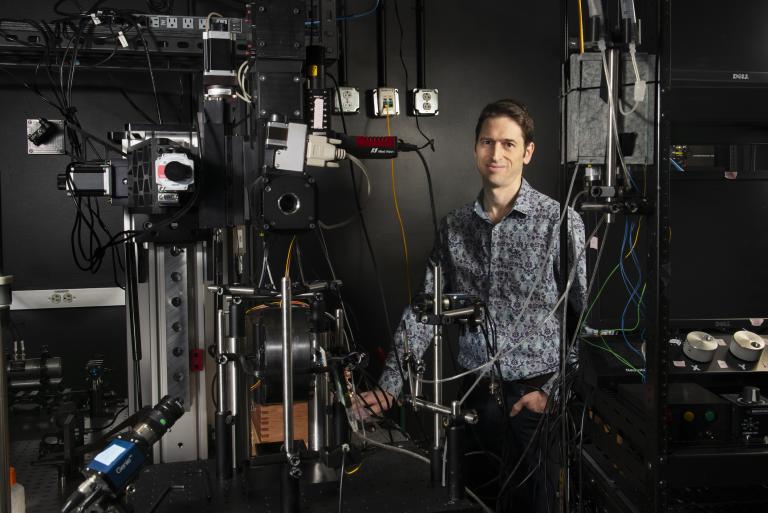Making Sense of Interoception
How we perceive what’s happening inside our bodies and what that means for our health
- 9 min read
- Feature

Even when the world around us seems quiet, our insides are bustling. Much of the time we’re unaware of the tumult within — of cells shifting shapes, organs releasing chemicals, or blood vessels dilating. But sometimes a signal breaks through, and we feel a pang of hunger, a fullness of the bladder, or a racing heartbeat. It’s a call from the body to the mind that something’s off, a plea for a return to balance.
This type of sensation has a name: interoception, which is loosely defined as the perception of internal signals from the body. While the five commonly recognized senses — sight, hearing, touch, taste, and smell — help us understand the world around us, interoception processes information from the heart, gut, lungs, and more as our internal organs interact with the brain.
Evidence is mounting that these internal senses are integral to keeping the body in balance and could be implicated in a number of medical conditions, such as anxiety, addiction, eating disorders, and chronic pain. Yet compared with our knowledge of the external senses, “for a long time we knew almost nothing at a molecular and cellular level about interoception,” says Stephen Liberles, a professor of cell biology in the Blavatnik Institute at HMS. That’s why Liberles and other researchers are exploring the molecular underpinnings of mind-body links, reshaping our understanding of how we sense what’s happening inside us and why it matters that we do.
Mixed signals
Take a pause, but don’t take your pulse: can you feel your heartbeat? In the early 1980s, German psychologist Rainer Schandry wondered whether some people might be better at perceiving their bodily processes than others. So, he asked a group of study participants to count their heartbeats simply by sensing them, without using their fingers to check their pulse. Schandry found that although participants’ heart rates didn’t vary much, some participants counted the number of beats far more accurately than others. Curiously, those who were better at sensing their heartbeats were more likely to report having anxiety.
The heartbeat-counting task became a go-to measure of the ability, known as interoceptive attention or interoceptive accuracy, to sense what’s happening inside one’s own body, and the task was applied in the ensuing decades to the study of many other psychiatric and neurological conditions. But whereas Schandry linked anxiety to increased interoceptive accuracy, later studies often found that individuals with autism, eating disorders, or depression were worse at perceiving their heartbeats or other sensations.
Perhaps, researchers posited, there’s a happy medium when it comes to interoception: You want to be aware of the messages your body is sending, but not too aware. A number of interventions have been introduced to find that balance. Most are used in the context of mindfulness-based practices, such as cognitive behavioral therapy. Some focus on helping patients reconnect with their bodily sensations, using mindful breathing or movement to treat anorexia or pain. Others, such as those used to treat anxiety, involve conditioned exposure to the sensations that trigger stress.

Wen Chen, MMSc ’98, PhD ’03, a branch chief at the National Center for Complementary and Integrative Health (NCCIH), part of the National Institutes of Health, was first exposed to the idea of interoception through these types of interventions. Given her interest in integrative health, she found the concept compelling, but as a neurobiologist, she noticed the researchers in her orbit were mostly focusing on the philosophical, clinical, and psychological dimensions of interoception. Nobody seemed to be diving into the fundamental science behind it. “I had this moment where I thought, what actually is interoception,” she says.
Chen thought of Liberles, a grantee in her program portfolio at NCCIH. Liberles wasn’t using the word “interoception” to describe his work at the time, but in the mid-2010s, he and colleagues characterized a subset of sensory neurons, called mechanoreceptors, that sense when the stomach is stretching and send signals to the brain, which cause a feeling of fullness. Chen invited Liberles to give a talk to a group of clinical researchers focused on interoceptive responses at an integrative medicine conference in 2018.
“I don’t think Steve had been to a meeting like that before, and we realized that there are very few people like him, studying the neurocircuitry of interoception,” says Chen. “It was quite eye-opening. The disconnect between the clinical research and basic research was so profound.”
Finding a sense of self
Although Liberles didn’t set out to study interoception, his research has helped fill the gap in understanding that Chen identified. He had been trying to map the cell types that make up the vagus nerve, a major brain-body communication highway. The vagus contains sensory neurons that innervate most of our vital organs, including the heart, lung, intestines, and stomach. Researchers had suspected for decades that the vagus nerve plays a key role in brain-body communication but knew almost nothing about how it works.
Liberles and colleagues focused on sensory neurons in the vagus nerves of mice. They used a technique called single-cell RNA sequencing, analyzing the gene expression of thousands of individual neurons to learn more about the role each one plays. They discovered about three dozen types of vagal neurons, each of which has distinct molecular properties and perceives specific types of information. The mechanoreceptors that sense stomach stretching are one example. Other types control breathing and coughing, detect blood pressure and oxygen changes, or sense when the airway is closing to induce gasping. Together they “detect a dizzying array of stimuli that they relay up to the brain,” says Liberles, “changing physiology, evoking perceptions like the state of fullness, and influencing mood.”
After deciphering the neurons in the vagus, Liberles and colleagues traced where those signals travel. They employed a technique called two-photon calcium imaging, which uses fluorescent molecules to illuminate neurons as they activate, allowing the researchers to observe how organs transmit messages from the vagus nerve to the brain.

They found that the first important stop for vagus signals is the brainstem, particularly the nucleus of the solitary tract, or NST. At the base of the skull, the cell bodies of vagus sensory neurons are intermingled, but as their signal-transmitting axons move into the NST they form what Liberles calls a “remarkable map” of internal organs. From there, signals can flow to the parabrachial nucleus, which sorts through those inputs, along with information from the spinal cord and some of the external senses.
The signals can also travel to higher brain regions involved in emotion, memory, and decision-making. But they don’t always do this, which may be why not all interoceptive signals reach conscious awareness. Some are simply “passively reporting what is sensed,” says Mark Andermann, an HMS professor of medicine and of neurobiology at Beth Israel Deaconess Medical Center. It wouldn’t be efficient to have every signal rising to the front of our minds. “But when something happens that makes you feel off, those are the moments when you shift your attention from the outside world to what’s going on inside,” Andermann adds. “That’s one of the next frontiers of understanding interoception at a mechanistic level.”
From sensation to awareness
Once these signals make it to higher levels of the brain, they can cause a vague feeling that something’s wrong, perhaps manifesting as a lousy mood or general malaise. Or they can trigger more specific feelings that demand action — such as a full bladder or an empty stomach.
One brain region in particular appears to activate when people consciously attend to their own interoceptive states: the insula, or insular cortex. In the 1950s, neurosurgeon Wilder Penfield discovered that electrical stimulation of this so-called hidden cortex caused curious internal sensations in his patients, such as an upset stomach or a “pang of fear” in the chest. Around the same time, other researchers found that the insula responded to stimulation of the vagus nerve.
“The body basically has a fast-lane highway to the insular cortex,” Andermann says. “The insula appears to track the internal sensations that accompany important experiences.”
Andermann and colleagues used a technique called optogenetics to explore the link between interoception, food intake, and the insula in mice. This involved adding a fluorescent sensor to the mice’s insular cortex neurons so researchers could observe neural activity. Over the course of a few years, they discovered neurons in the insula that exhibit specific patterns linked to states of fullness, hunger, thirst, or other interoceptive sensations.
They also found something that took Andermann by surprise. Simply showing a mouse a photo of food or water was enough to trigger specific changes in the neural activity patterns in the insula. For example, if a thirsty mouse saw a picture of a drop of water, the neurons in its insular cortex temporarily adopted the pattern associated with being quenched before quickly returning to the pattern indicating thirst.

Andermann suspects this indicates an important function of the insula, and of interoception more broadly: to orchestrate our behavior by giving us a preview of how our bodies will feel if we make certain decisions. For example, you see an apple, and the insula gives you a glimpse of what you’ll feel when you eat it, which depends on how hungry you are. You see a dish that once made you sick, and the nausea returns for a second. Or you stumble upon a bear while hiking and your heart rate increases, your breathing quickens, and your palms sweat. The next time you walk close to the same spot, you begin feeling those visceral sensations again, and you decide to take a different route.
A new mind-body paradigm
These findings also suggest that interoception is not a one-way street. “A very traditional definition of interoception is that it comes from the body and ends in the brain,” says Chen, who oversees interoception research initiatives at the NCCIH. “But we now know that the brain can go back and regulate signals in organs. It’s a loop.”
When it comes to sensations of hunger, for example, the brain is not “passively serving as a bean counter that measures how many calories a food gives us after we digest it,” Andermann says. Rather, it’s making preemptive changes. Your brain sends signals that make you feel full well before you’ve digested your food so that you don’t overeat.
Recognizing that feedback loop between the brain and body opens up new possibilities for understanding disease. Chen says there is evidence that many of the conditions we think of as brain disorders — depression and Alzheimer’s disease, for example — could originate outside the brain, and that there are likely peripheral ailments — like nausea, hypertension, and urinary incontinence — that sometimes originate in the brain. “That’s what is really intriguing about interoception,” she says. “If we can figure out all of the connections between the body and the brain, that could help us figure out what the best treatment paradigms are.”
It’s so important for us to understand, because we’re basically studying ourselves.”
Liberles, Andermann, and other researchers are showing that the concept of interoception is far more nuanced than looking at how a person performs on a task like counting heartbeats. Rather, interruptions or hypersensitivities are possible in any of the receptors or pathways sending messages from peripheral parts of the body to the brain, as well as in the higher brain regions where those signals can travel.
If the pathways found in mice share similarities with those in humans, dialing them up or down “could offer tremendous therapeutic potential,” says Liberles. Imagine, for example, treating nausea or pain by dialing down pathways related to feelings of illness, developing medications for eating disorders or obesity that target sensory receptors in the gut, or treating panic disorder by targeting an insula that’s in overdrive. “In animals, we can test out medications that might be able to turn up and down these dials,” echoes Andermann, adding that recent research suggests that mice and humans share similar types of neurons related to interoception.
But studying interoception requires a shift from focusing on individual organs to focusing on the body as a whole, which has raised some practical challenges. Interoception “is so big that everybody has been a little bit scared to support it,” says Chen. Still, the field has grown in recent years, with scientists creating maps not only of the vagus nerve and the insula but of other parts of the body as well, such as messages traveling through the spinal cord and interoceptive signals in the hypothalamus. “It’s kind of crazy to see it go from no one working on it to being ridiculously popular in neuroscience these days,” says Liberles. “But it’s been a fun ride.”
“It’s so important for us to understand, because we’re basically studying ourselves and how our mind is connected to our body in a very integrated and comprehensive way,” says Chen. “Interoception is us.”
Molly McDonough is the associate editor of Harvard Medicine.
Images: Stephanie Dalton Cowan (illustration); Mark Finkenstaedt (Chen); Gretchen Ertl (Liberles); Anna Olivella (Andermann)
Continued funding uncertainty jeopardizes promising HMS research advances.